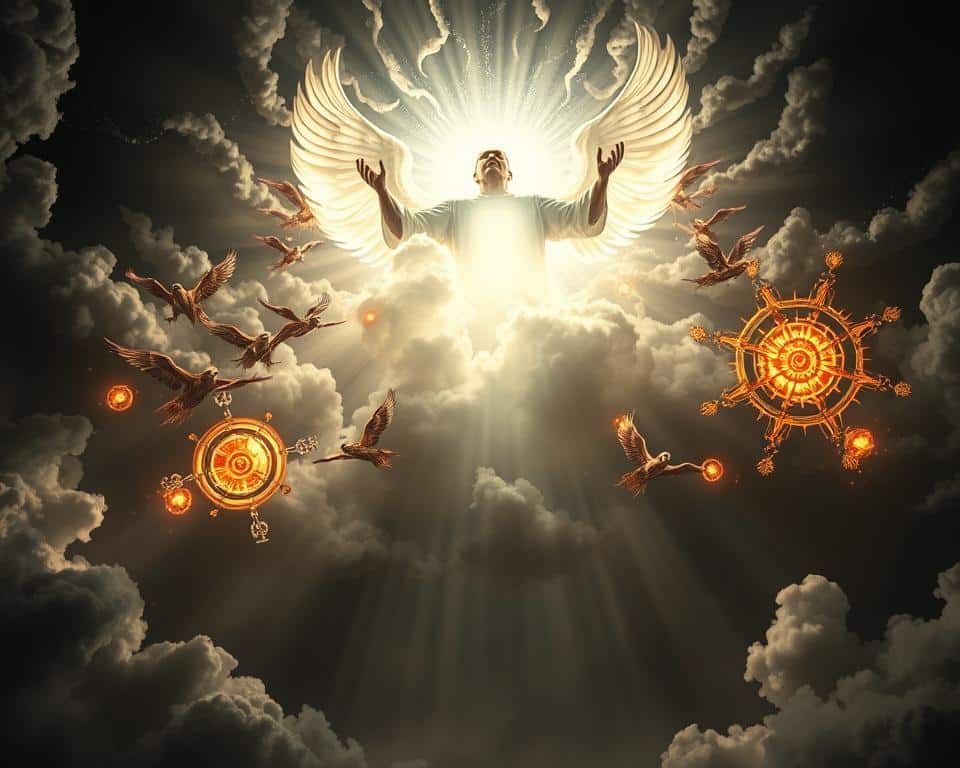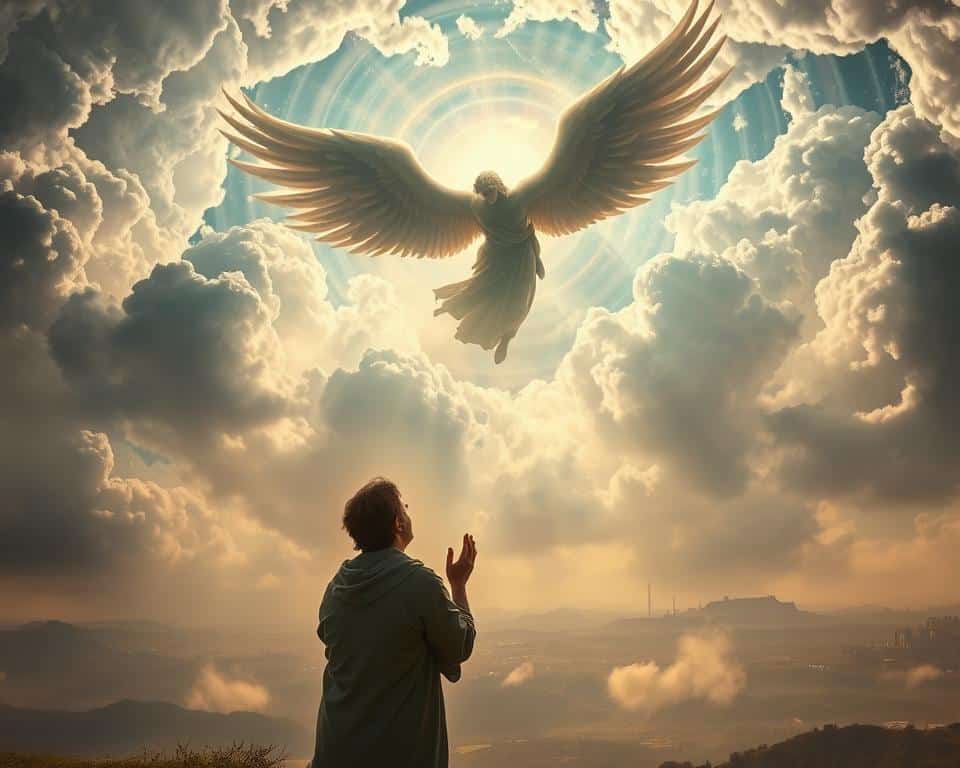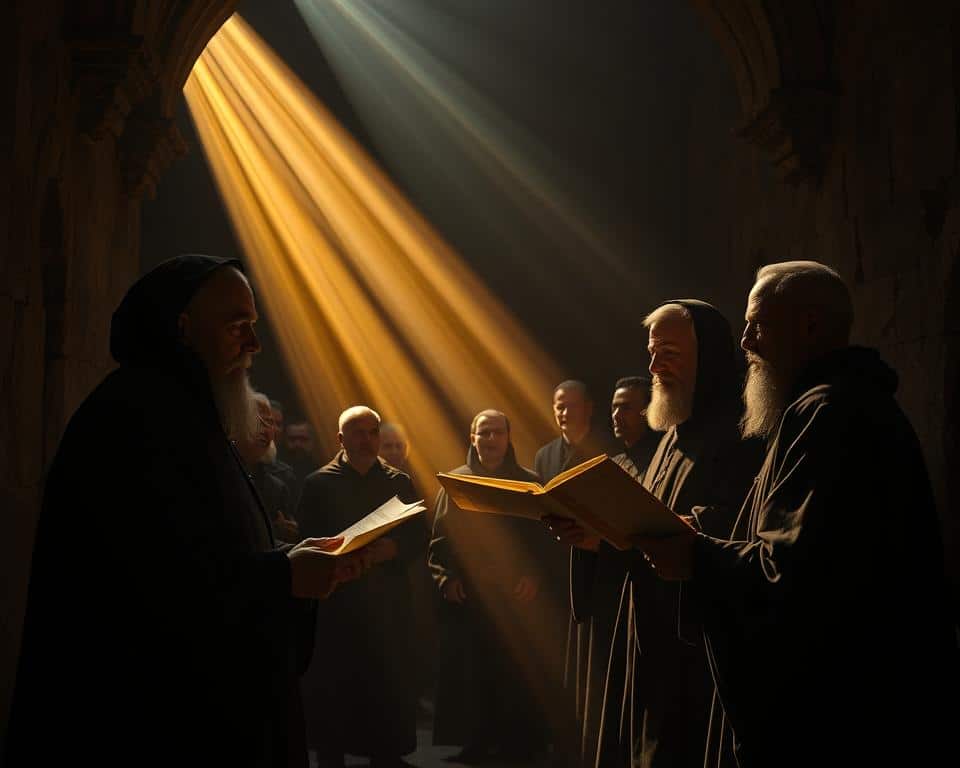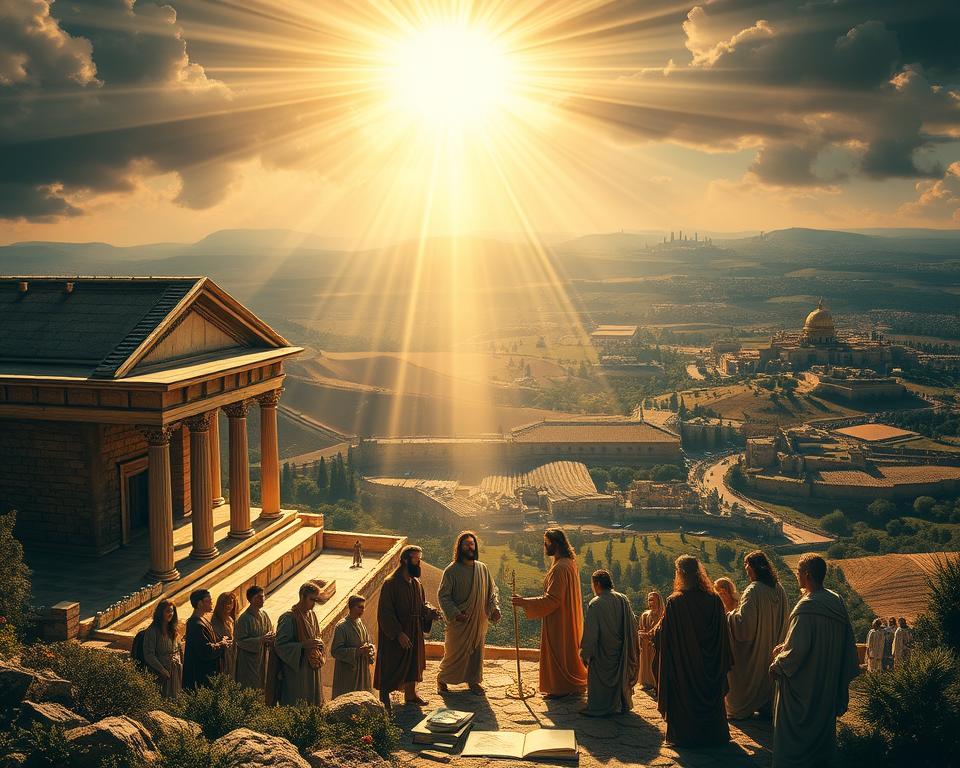Have you ever wondered how ancient prophecies still speak to us today? Ezekiel, a priest and prophet during Israel’s exile, delivered powerful messages of judgment and hope. His visions, recorded in 48 chapters, reveal God’s plan for restoration—both for his people then and for us now.
Written over 22 years (593-571 BC), Ezekiel’s words highlight God’s covenant faithfulness. They point to a future where the temple symbolizes humanity’s reconciliation with Him. Whether you’re studying Scripture or seeking deeper faith, these prophecies offer timeless truth.
Let’s explore how Ezekiel’s warnings and promises still matter in our lives today.
Who Was Ezekiel and Why Do His Prophecies Matter?
Few biblical figures experienced such a radical shift in circumstances as Ezekiel. Born into a priestly family, his life took a dramatic turn when Babylon invaded Judah. At age 25, he was forcibly taken into exile alongside 10,000 others—a defining moment for God’s people.

Ezekiel’s Background as a Priest and Prophet
Ezekiel’s priestly training prepared him to serve in Jerusalem’s temple. But God had other plans. At 30, he received a divine call by the Chebar River (Ezekiel 1:1-3). For 22 years, he ministered to fellow exiles in Tel Abib, blending priestly care with prophetic urgency.
Unlike Jeremiah, who warned Jerusalem’s residents, or Daniel, who served in royal courts, Ezekiel spoke to displaced Jews. His dual role as pastor and prophet offered hope amid judgment.
The Historical Context of Babylonian Exile
Judah’s captivity wasn’t sudden. Moses had warned centuries earlier that idolatry would lead to loss of the land (Leviticus 26). By Ezekiel’s time, Assyria and Babylon had crushed the northern and southern kingdoms. Judah’s rebellion sealed its fate as a nation.
Yet even in exile, God remained faithful. Ezekiel’s visions reminded the people that restoration was possible—a message still relevant today.
Ezekiel’s Call and Early Visions
God’s glory appeared to Ezekiel in a way no one could ignore. By the Chebar River, the exiled priest saw a vision that changed his life—and still speaks to us today.

The Throne Chariot and God’s Glory
Ezekiel 1 describes a dazzling scene: four living creatures with faces of a lion, ox, eagle, and man. Their wings stretched beneath a crystal platform, where a throne shone like fire. Above it sat the “glory of the Lord” (Ezekiel 1:28).
The “wheels within wheels” symbolized God’s mobility—He wasn’t confined to Jerusalem’s temple. For exiles, this message was clear: Yahweh remained with them, even in Babylon.
“The appearance of the likeness of the glory of the Lord was like a consuming fire.” —Ezekiel 1:28
Ezekiel’s Commission as a Watchman
God called Ezekiel to be a prophet in an unusual way. He ate a scroll inscribed with “lamentations and woe” (Ezekiel 2:10), symbolizing his call to deliver hard truths. For seven years, he spoke only divine messages—a sign of total obedience.
His role as a “watchman” (Ezekiel 3:17) required warning Israel of judgment. Today, we’re similarly called to share Scriptural truth with love.
- Reassurance: The throne chariot proved God’s presence in exile.
- Responsibility: Like Ezekiel, we must deliver God’s word faithfully.
- Restoration: Even judgment points to hope.
Prophecies Against Jerusalem and Judah
Ezekiel’s warnings to Jerusalem weren’t just ancient history—they mirror struggles we face today. Through dramatic acts and visions, he revealed the city Jerusalem’s spiritual collapse and God’s call to repentance.
The Siege Symbolized: A 430-Day Warning
For over a year, Ezekiel lay on his side, acting out Jerusalem’s siege (Ezekiel 4:4–6). Each day represented a year of Judah’s rebellion. His bread, cooked over dung, foreshadowed famine and death.
In another shocking act, he shaved his hair, dividing it into thirds (Ezekiel 5:1–4). This symbolized judgment: some would burn in the city, others die by sword, and a few be scattered among nations. Yet a remnant—tied to his robe—showed God’s mercy.
“I will withdraw My glory from them.” —Ezekiel 11:23
Idolatry and Injustice in God’s House
Ezekiel’s temple vision (Ezekiel 8–11) exposed secret sins. Leaders worshiped idols in hidden rooms, wept for the pagan god Tammuz, and faced the sun—a slap to God’s covenant. Their actions bred social injustice, exploiting the poor while pretending piety.
Today, idolatry wears new masks: materialism, power, or even busyness replacing faith. Like Judah, we risk hollow worship if our hearts stray from Scripture.
- God’s Glory vs. Human Corruption: The temple’s defilement forced God’s presence to depart (Ezekiel 10:18–19). Yet He promised restoration: “I will give them one heart” (Ezekiel 11:19).
- Modern Parallels: Justice falters when we prioritize comfort over compassion. Ezekiel’s message urges self-examination.
Across four chapters, Ezekiel balanced wrath and hope. The time for Judah’s reckoning came, but so did a promise—a future where God’s people would live by His Spirit.
The Fall of Jerusalem and Its Aftermath
Ezekiel’s personal loss mirrored the city’s impending destruction. His prophecies reached their most intense period as Babylon’s siege tightened around Jerusalem. Through symbolic acts and divine messages, he revealed both the cost of rebellion and the promise of renewal.
Ezekiel’s Warning of Destruction
God commanded Ezekiel to pack an exile’s bag and dig through a wall (Ezekiel 12:1–7). This street theater previewed King Zedekiah’s fate—blinded and dragged to Babylon, fulfilling Jeremiah’s parallel prophecy. The year-long siege left no doubt: judgment had come.
Ezekiel 18 delivered a radical truth: “life or death depends on individual faithfulness.” Unlike their ancestors’ punishment, each person now bore responsibility for their choices. This shifted focus from collective guilt to personal repentance.
“The soul who sins shall die.” —Ezekiel 18:4
The Death of Ezekiel’s Wife as a Sign
In 585 BC, Ezekiel’s beloved wife died as Jerusalem fell. God forbade mourning—a shocking command highlighting the city’s deserved judgment (Ezekiel 24:15–18). The prophet’s silence mirrored God’s grief over necessary justice.
This personal sacrifice underscored a greater truth: sin’s consequences affect even the faithful. Yet Ezekiel 16:60–63 revealed hope. God promised an everlasting covenant, covering shame with grace. The seven-month burial period later symbolized cleansing after Gog’s defeat.
- Human Cost: Ezekiel’s loss showed prophecy’s personal weight
- Divine Justice: Jerusalem’s fall confirmed God’s warnings
- Hopeful Turn: Judgment paved the way for restoration
Through exile and death, Ezekiel’s message remained clear: God’s holiness demands justice, but His love offers redemption. That tension still speaks to us today.
Prophecies Against Surrounding Nations
God’s justice extends beyond Israel to all nations. Ezekiel 25–32 reveals how pride and malice invited divine judgment. These events remind us that no kingdom escapes accountability.
Judgment on Ammon, Moab, and Edom
Ezekiel 25 exposes three enemies of Israel:
- Ammon: Celebrated Jerusalem’s fall (Ezekiel 25:3). Their malice earned destruction.
- Moab: Mocked Israel’s faith. God declared, “They will know I am the Lord” (Ezekiel 25:11).
- Edom: Took vengeance on Judah. Their mountains became wastelands.
Each nation chose a way of arrogance. Their fates show God’s fairness—He judges all equally.
The Downfall of Tyre and Egypt
Tyre’s wealth bred hubris. Ezekiel 26–28 compares its king to Satan: “Your heart grew proud because of your beauty” (Ezekiel 28:17). Babylon’s siege engines crushed its maritime pride.
“I will bring you to a dreadful end.” —Ezekiel 28:19
Egypt’s Pharaoh claimed divinity: “Like a monster, you lie in your rivers” (Ezekiel 29:3). God sentenced it to 40 years of desolation. Yet even mighty world powers answer to Him.
These prophecies teach timeless truths: Oppressing God’s people invites consequences, and temporary power never rivals eternal sovereignty.
The Promise of Restoration for Israel
After judgment comes hope—Ezekiel’s message shines brightest in restoration. Chapters 34 and 36 reveal God’s plan to rebuild His people. You’ll see His covenant faithfulness in action, pointing to Christ’s work today.
The New David and Messianic Hope
Ezekiel 34 condemns Israel’s leaders as selfish shepherds. But God promises a new david: “I will set up one shepherd, my servant David” (Ezekiel 34:23). This isn’t King David revived—it’s Jesus, the Good Shepherd.
“They will live in security, and no one will make them afraid.” —Ezekiel 34:28
Jesus fulfills this in John 10:11, laying down His life for the flock. Unlike Ezekiel’s failed leaders, Christ guides us with perfect love.
A New Heart and Spirit
Ezekiel 36 offers radical transformation. God pledges: “I will remove your heart of stone and give you a heart of flesh” (Ezekiel 36:26). This isn’t self-improvement—it’s Holy Spirit power.
Notice the grace: “It is not for your sake that I will act” (v.22). Like baptism’s clean water (v.25), renewal starts with God’s initiative.
- From Stone to Flesh: The Spirit writes God’s law on our hearts (Jeremiah 31:33).
- Land Restored: Israel’s future revival foreshadows Christ’s millennial reign.
- Practical Faith: Daily surrender lets God reshape our desires.
Ezekiel’s vision stretches beyond the land israel to eternity. What God began in exile, He completes in Christ—offering hope to all who trust Him.
The Vision of Dry Bones: Resurrection and Renewal
Imagine standing in a valley full of dry bones—what could God possibly do with them? Ezekiel’s vision (Ezekiel 37:1–14) answers this with stunning clarity. It’s not just about Israel’s hope but a blueprint for how God revives what seems dead.
Symbolism of the Dry Bones
God showed Ezekiel a valley of bones, brittle and scattered. “Can these bones live?” He asked (Ezekiel 37:3). The prophet’s hesitant “Lord, You know” reveals our own doubts. Yet when Ezekiel spoke God’s word, tendons formed, flesh replaced dust, and breath entered lifeless bodies.
This mirrors Jesus raising Lazarus (John 11)—both show God’s power over life and death. For Israel, the bones symbolized their exile: “Our bones are dried up; our hope is lost” (Ezekiel 37:11). But God promised restoration, just as He renews our faith today.
The Reunification of Israel and Judah
Next, Ezekiel took two sticks—labeled “Judah” and “Joseph”—and joined them (Ezekiel 37:15–19). This signaled a future where divided tribes would unite under one way: God’s covenant. A “Davidic prince” (v.24–25) would rule, pointing to Christ’s eternal kingdom.
Adventists see this as both historical and prophetic. Revelation 20 describes two resurrections: first for the faithful, then final judgment. Like dry bones rising, God’s people will awaken to His israel future—a world made new.
“Then you will know that I am the Lord.” —Ezekiel 37:14
- National Revival: The bones represent Israel’s restoration.
- Eternal Promise: Christ’s resurrection guarantees ours.
- Covenant Fulfillment: “Know I am the Lord” anchors God’s faithfulness.
The Battle of Gog and Magog
The battle of Gog and Magog is one of Ezekiel’s most debated visions—what does it truly mean? This prophecy (Ezekiel 38–39) isn’t about fear but faith. It reveals God’s power over every threat, whether ancient or modern.
Who Are Gog and Magog?
Gog, a leader from Magog (Ezekiel 38:2), represents a coalition of nations opposing God’s people. Scholars link Magog to Genesis 10:2’s Scythians—nomadic tribes north of Israel. Ezekiel’s vision isn’t about one time but God’s pattern of deliverance.
Revelation 20:8 reuses Gog/Magog as symbols of end-time rebellion. The dual fulfillment shows Scripture’s layers: historical judgment and future hope.
“I will turn you around, put hooks in your jaws, and bring you out with your whole army.” —Ezekiel 38:4
God’s Victory Over Evil
Ezekiel 39 predicts Gog’s defeat with vivid imagery. Weapons become fuel for seven years (v.9), echoing Isaiah 2:4’s peace prophecy. The seven-month burial (v.12–14) signifies cleansing—a world restored after chaos.
Fire in judgment (Ezekiel 39:17–20) mirrors Pentecost’s flames (Acts 2:3). Both show God’s purifying presence. Here’s what this means for us:
- Divine Sovereignty: No enemy—human or spiritual—thwarts God’s plan.
- Hope in Judgment: Even battles point to Christ’s final victory.
- Practical Faith: Trust God’s timing when evil seems strong.
Ezekiel’s message is clear: God wins. Whether facing ancient foes or today’s struggles, His covenant stands unshaken.
The Future Temple and God’s Presence
What does a temple built for eternity look like? Ezekiel’s vision holds the answer. In chapters 40–48, he describes a sanctuary so grand it dwarfs Solomon’s. This isn’t just architecture—it’s a blueprint of God’s future reign. For exiles longing for home, it offered hope. For us, it reveals Christ’s promise to dwell with His people.
Ezekiel’s Detailed Vision (Ezekiel 40–43)
A heavenly guide measured every wall, gate, and chamber (Ezekiel 40:3–5). The east gate, permanently shut (Ezekiel 44:1–2), signaled God’s glory would never depart again. Adventists see parallels here:
- Sanctuary Doctrine: The millennial temple mirrors Christ’s heavenly ministry (Revelation 11:19).
- Zadokite Priests: Only those faithful in exile could serve (Ezekiel 44:15–16)—a call to purity in life.
“The glory of the Lord entered the temple by the east gate.” —Ezekiel 43:4
The River of Life and Healing (Ezekiel 47)
From the temple’s threshold, a trickle became a river too deep to cross (Ezekiel 47:1–5). It healed the Dead Sea—a land once barren. This echoes Eden’s rivers (Genesis 2:10) and Revelation’s world-renewing stream (Revelation 22:1–2).
Here’s the beauty: God’s presence transforms death into life. Whether literal or symbolic, the message is clear. In the end, His restoration wins.
Dual Fulfillment: Past and Future Meanings
Prophecies often unfold in layers—what seemed fulfilled in Ezekiel’s day still points forward. This “already/not yet” pattern shows God’s word transcends time. While some events directly addressed Israel’s exile, others stretch toward Christ’s return.
How Ezekiel’s Prophecies Applied to His Time
The 586 BC siege of Jerusalem confirmed Ezekiel’s warnings. His 430-day acted-out siege (Ezekiel 4:4–6) used the day-year principle—each day symbolized a year of Judah’s rebellion. This wasn’t guesswork; it was divine precision.
Consider the temple vision (Ezekiel 8–11). When leaders secretly worshiped idols, God’s glory departed—a direct warning to Ezekiel’s generation. Yet even in judgment, hope remained: “I will gather you from the nations” (Ezekiel 11:17).
“Then they will know that I am the Lord.” —Ezekiel 6:7
Modern Interpretations and End-Time Significance
Today, Ezekiel’s words still resonate. The dry bones vision (Ezekiel 37) isn’t just about Israel’s 1948 rebirth—it foreshadows the resurrection at Christ’s return. Gog’s defeat (Ezekiel 38–39) mirrors Revelation’s end-time battles.
Here’s how to apply these truths:
- Watchman Role: Like Ezekiel, believers must share God’s warnings with love.
- Tribal Identities: Anglo-Saxon nations may carry Israelite-descended remnants, but God’s covenant extends to all who follow Christ.
- Hermeneutic Balance: Avoid date-setting while recognizing prophecy’s future dimensions.
The temple vision (Ezekiel 40–48) especially matters. Its river of life previews the new earth—where God’s presence renews the whole world. That’s the ultimate fulfillment of Ezekiel’s prophecies.
Ezekiel’s Message for Today
What does a 2,600-year-old prophet have to say to your daily walk with God? Ezekiel’s message cuts through time with urgency. While his context was exile, his call to repentance and hope speaks directly to modern struggles.
Lessons on Repentance and Obedience
God declared through Ezekiel: “I take no pleasure in the death of anyone… Repent and live!” (Ezekiel 18:32). This wasn’t empty religion—it demanded heart change. Today, cultural compromise often dulls our sense of sin. But Scripture remains clear.
Ezekiel 36:26-27 reveals the solution: “I will give you a new heart… I will put my Spirit in you.” Obedience flows from divine transformation, not willpower. Like Ezekiel’s watchman role, we’re called to share this truth with love.
“Turn! Turn from your evil ways!” —Ezekiel 33:11
Hope Amid Judgment
Even in exile, Ezekiel promised restoration. His valley of dry bones (Ezekiel 37) shows God can resurrect dead situations. This hope anchors us when life crumbles.
Three practical applications:
- Watchman Responsibility: Like David, we must courageously uphold God’s word.
- Heart Renewal: Daily Scripture study reshapes desires (Ezekiel 36:26).
- Active Expectation: Christ’s return isn’t theory—it’s our living hope.
Ezekiel’s covenant language still reassures: “Then you will know that I am the Lord” (Ezekiel 6:7). Whether facing personal exile or global chaos, His presence transforms death into life.
The Legacy of Ezekiel’s Prophecies
Jesus Himself echoed Ezekiel’s call to restore the broken (Luke 4:18-19). Centuries later, His words still guide us. Ezekiel’s balance of God’s holiness and mercy reveals a way forward—even in exile.
His visions shaped apocalyptic literature, from Revelation’s throne chariot to the Dead Sea Scrolls’ eight manuscripts. You’ll find hope here: dry bones rising, temples rebuilt, and a covenant renewed.
For Adventists, Ezekiel’s prophecies affirm God’s plan for this world. They urge verse-by-verse study, revealing layers of meaning. The New Covenant isn’t theory—it’s alive in Christ.
Let Ezekiel’s legacy inspire you. Embrace its promises, and watch faith transform your future.





